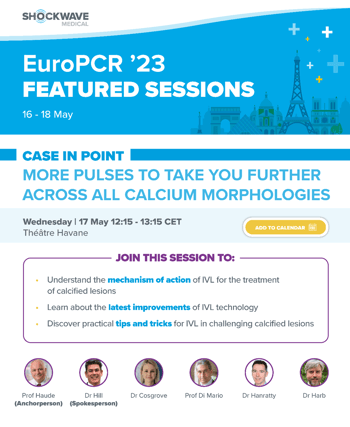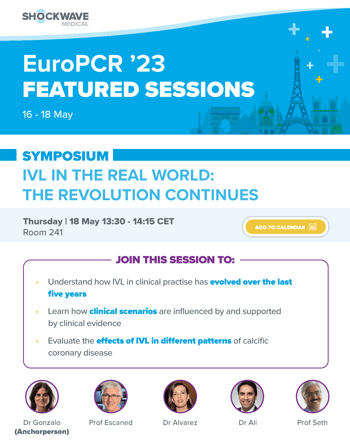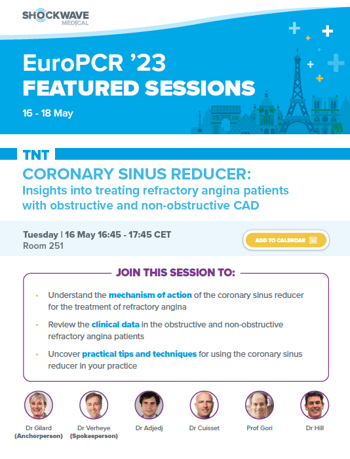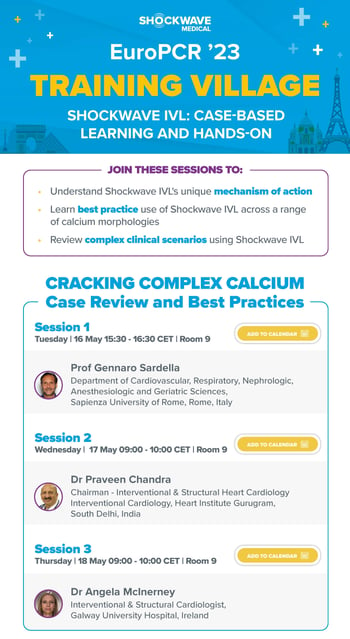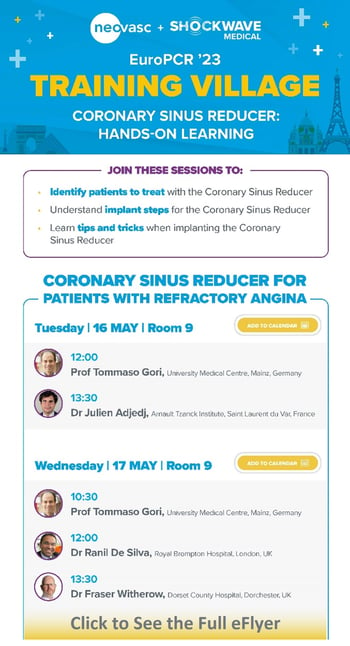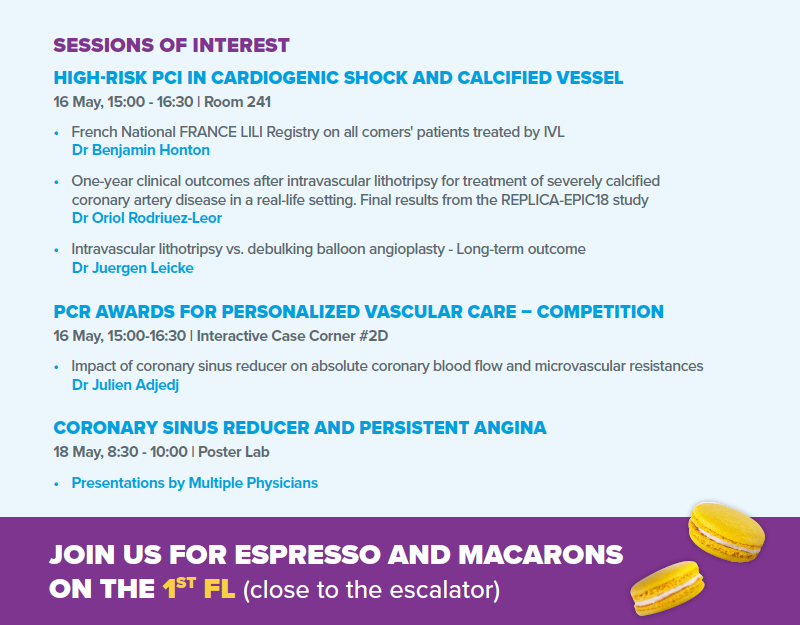EuroPCR 2023: Let’s Crack What’s Next!
After 5 years of innovating together, we’re just getting started! Join us at EuroPCR 2023 to celebrate with us 5 years of Coronary IVL and find out more about our brand-new catheter, Shockwave C2+. We will go through the results of the latest clinical studies in our Symposium and discuss the main features of the new Shockwave C2+ in our Case in Point session.
With the recent acquisition of Neovasc and their innovative Reducer™ device, we are creating new opportunities for patients and physicians in the treatment of refractory angina. Join us at the Tools & Techniques session to learn how we are working to bring these patients relief from their symptoms and hopefully improve their quality of life.
À bientôt à Paris!
MORE PULSES TO TAKE YOU FURTHER ACROSS ALL CALCIUM MORPHOLOGIES
Wednesday 17 May - 12:15 to 13:15 | Théâtre Havane
In this case-based session, Prof Michael Haude and Dr Jonathan Hill will lead a great panel in an interesting discussion about the new Shockwave C2+ catheter and demonstrate its use in complex calcified lesions such as bifurcations, eccentric calcium and nodular calcium.
IVL IN THE REAL WORLD: THE REVOLUTION CONTINUES
Thursday 18 May - 13:30 to 14:15 | Room 241
In our symposium, Dr Nieves Gonzalo will guide us through the last 5 years of Coronary IVL. Prof Javier Escaned and Dr Ashok Seth will share their experience in real-life cases with IVL for calcium modification, while Drs Ziad Ali and Ana Belen Cid Alvarez will highlight the results of clinical studies showing the efficacy of IVL.
CORONARY SINUS REDUCER: INSIGHTS INTO TREATING REFRACTORY ANGINA PATIENTS WITH OBSTRUCTIVE AND NON-OBSTRUCTIVE CAD
Tuesday 16 May - 16:45 to 17:45 | Room 251
In this session, Prof Martine Gilard leads a distinguished panel of experts in a discussion about refractory angina patients, their prevalence, where to find them, and how to help alleviate their symptoms using the Neovasc Reducer. They will also highlight a case and show tips and tricks on implanting the Reducer.
SHOCKWAVE IVL & NEOVASC REDUCER TRAINING VILLAGES
Click the eFlyer Images for Dates, Times & Speakers
Join us at our Training Villages for both Shockwave IVL and Neovasc Reducer case-based learning sessions and hands-on experiences with the devices. Click the eFlyers below for full information and add the sessions to your calendar.
SHOCKWAVE IVL & NEOVASC REDUCER SESSIONS OF INTEREST
Click the eFlyer Image for More
To keep up on the real-time Shockwave IVL activities at EuroPCR 2023, follow @ShockwaveIVL on Twitter!
Coronary IVL Important Safety Information
Please contact your local Shockwave representative for specific country availability and refer to the Shockwave C2 and Shockwave C2+ instructions for use containing important safety information.
In the United States: Rx only
Indications for Use—The Shockwave Intravascular Lithotripsy (IVL) System with the Shockwave C2 Coronary IVL Catheter is indicated for lithotripsy enabled, low-pressure balloon dilatation of severely calcified, stenotic de novo coronary arteries prior to stenting.
Contraindications—The Shockwave C2 Coronary IVL System is contraindicated for the following: This device is not intended for stent delivery. This device is not intended for use in carotid or cerebrovascular arteries.
Warnings— Use the IVL Generator in accordance with recommended settings as stated in the Operator’s Manual. The risk of a dissection or
perforation is increased in severely calcified lesions undergoing percutaneous treatment, including IVL. Appropriate provisional interventions should be readily available. Balloon loss of pressure was associated with a numerical increase in dissection which was not statistically significant and was not associated with MACE. Analysis indicates calcium length is a predictor of dissection and balloon loss of pressure. IVL generates mechanical pulses which may cause atrial or ventricular capture in bradycardic patients. In patients with implantable pacemakers and defibrillators, the asynchronous capture may interact with the sensing capabilities. Monitoring of the electrocardiographic rhythm and continuous arterial pressure during IVL treatment is required. In the event of clinically significant hemodynamic effects, temporarily cease delivery of IVL therapy.
Precautions— Only to be used by physicians trained in angiography and intravascular coronary procedures. Use only the recommended balloon
inflation medium. Hydrophilic coating to be wet only with normal saline or water and care must be taken with sharp objects to avoid damage to the hydrophilic coating. Appropriate anticoagulant therapy should be administered by the physician. Precaution should be taken when treating patients with previous stenting within 5mm of target lesion.
Potential adverse effects consistent with standard based cardiac interventions include– Abrupt vessel closure – Allergic reaction to contrast medium, anticoagulant and/or antithrombotic therapy-Aneurysm-Arrhythmia-Arteriovenous fistula-Bleeding complications-Cardiac tamponade or pericardial effusion-Cardiopulmonary arrest-Cerebrovascular accident (CVA)-Coronary artery/vessel occlusion, perforation, rupture or dissection-Coronary artery spasm-Death-Emboli (air, tissue, thrombus or atherosclerotic emboli)-Emergency or non-emergency coronary artery bypass surgery-Emergency or non-emergency percutaneous coronary intervention-Entry site complications-Fracture of the guide wire or failure/malfunction of any component of the device that may or may not lead to device embolism, dissection, serious injury or surgical intervention-Hematoma at the vascular access site(s)-Hemorrhage-Hypertension/Hypotension-Infection/sepsis/fever-Myocardial Infarction-Myocardial Ischemia or unstable angina-Pain-Peripheral Ischemia-Pseudoaneurysm-Renal failure/insufficiency-Restenosis of the treated coronary artery leading to revascularization-Shock/pulmonary edema-Slow flow, no reflow, or abrupt closure of coronary artery-Stroke-Thrombus-Vessel closure, abrupt-Vessel injury requiring surgical repair-Vessel dissection, perforation, rupture, or spasm.
Risks identified as related to the device and its use: Allergic/immunologic reaction to the catheter material(s) or coating-Device malfunction, failure, or balloon loss of pressure leading to device embolism, dissection, serious injury or surgical intervention-Atrial or ventricular extrasystole-Atrial or ventricular capture.
Prior to use, please reference the Instructions for Use for more information on warnings, precautions and adverse events.
https://shockwavemedical.com/IFU
Neovasc Reducer Important Safety Information
Caution: In the United States, Reducer is an investigational device, limited by United States law to investigational use.
Reducer is commercially available in certain countries outside the U.S. Please contact your local representative for specific country availability.
Prior to use, please reference the Instructions for Use for more information on warnings, precautions and adverse events.
ifu.neovasc.com

